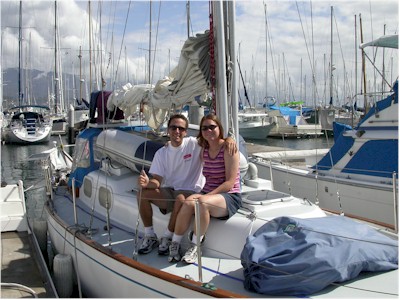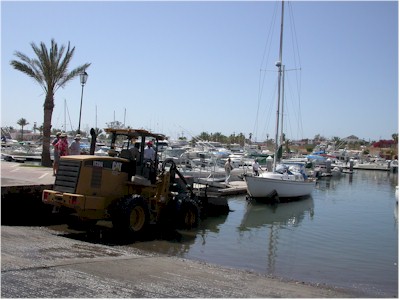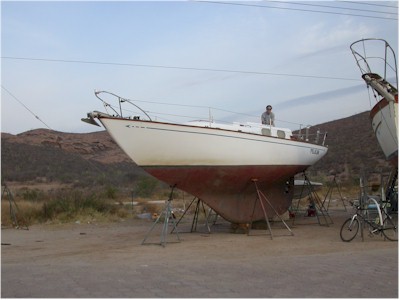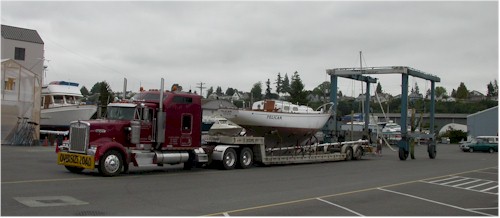
The crew of Pelican
made it to California!
 |
|
The crew of Pelican |
When my husband Michael and I turned left out of the Strait of Juan de Fuca last August, headed ultimately for a warm winter in Mexico, we had no idea how, when, or if we would be returning to the Puget Sound area when our cruise was over. Over the next nine months, we had the experience of a lifetime as we sailed our 1965 Pearson Alberg 35 Pelican south to San Francisco Bay, California’s Channel Islands, San Diego, then down Mexico’s Baja California, over to Puerto Vallarta and as far south as Tenacatita.
We thoroughly enjoyed our blissful days spent swimming, reading, having potlucks with new friends and exploring Mexico, but we knew we’d have to decide what our future held for us. Over time, our cruising kitty made the decision for us as it just kept getting smaller and smaller. We also missed our families and friends back in the Puget Sound and knew that area would remain our home in the future. We’d made a trip in our sailboat several years earlier up the inside passage through British Columbia to Alaska and our memories of the intense natural beauty of the north, plentiful calm anchorages, and warm people kept calling us back.
As the Mexican winter progressed, it became clear to us that we’d be ready to return home with Pelican by the time the summer temperatures began to rise. The only question now was – how?
After talking with other cruisers and doing some research in internet cafes, it became apparent that we had four basic options for getting us and Pelican home the next summer.
1. Sail to Hawaii: This was the option the previous owners of Pelican had chosen a few years earlier when they returned to the Northwest from Mexico. This method would mean 20-30 days at sea on the warm reach to Hawaii from Cabo San Lucas, then a 20-30 day trip getting colder and colder with possible beating up to Alaska or Canada. Since we cruise with our two cats, we’d have to arrange an expensive quarantine stay when we arrived at the Hawaiian islands due to rabies regulations. For us though, it would be a wonderful month-plus long vacation in some tropical islands neither of us had visited before.
2. Bash up the Pacific coast to Washington: This option was the least appealing, since it would mean days of motoring between weather systems and for sure some ugly pounding against wind and waves. We figured that this method would take at least a month with many days in various marinas located on the coast. Not only that, if we were caught going north when the winds picked up, it might mean expensive repairs to Pelican’s gear should anything break on the bash north, which was a likely possibility.
3. Ship Pelican home: Dockwise Yacht Transport offers yacht shipping around the world; in our case we could drive Pelican onto the semi-submersible ship and she’d sail safe and dry on the deck of the ship from Lazaro Cardenas, Mexico (just north of Ixtapa/Zihuatanejo) to Vancouver B.C. After arriving, we’d be able to drive her off the submersed ship and sail away. There was one scheduled shipping date on this route for August 2003 and the quoted cost for our 35’ sailboat was $5,500 (Note: Dockwise just announced additional service from La Paz, B.C.S.).
4. Truck Pelican home: Not only can a boat be trucked north from San Diego after doing the “Baja Bash” up the Pacific side of Baja, but we had the option of skipping bashing altogether and trucking her right from San Carlos. Marina San Carlos (located on Mainland Mexico about 250 miles south of the border, near the middle of the Sea of Cortez) has been offering trucking services to and from the United States for the past several years. Marina San Carlos, using their brand new semi-truck and air-ride hydraulic trailer will transport your sailboat to Tucson, Arizona where the boat will be loaded onto the trailer of a U.S. yacht trucking company of your choice for the remainder of the trip. Our quote for this trip was $5860 using Dudley Boat Transportation for the portion from Tucson to Seattle. In comparison, Dudley would charge us around $3000 to drive her from San Diego to Seattle.
 |
|
Hauling out at Marina |
Bashing up the coast to Seattle was our least favorite option, simply due to the possible misery we may have to endure pounding against wind and waves that had been great fun to surf down on our trip south. We seriously considered sailing to Hawaii, but with the knowledge that our old, sun-worn sails may not make the trip, plus knowing we’d spend a huge chunk of money playing tourists for a month or two, not to mention having to lock up our cat crew members for the duration of our visit, made us look more closely at the shipping/trucking options.
Shipping using Dockwise Yacht Transport was very attractive as we wouldn’t have to de-commission Pelican for the trip north (i.e. take the mast down, plus remove all deck equipment that was required for trucking). However, the ship wasn’t leaving until August and we really didn’t relish the thought of having to bear the heat of Mexico’s midsummer waiting for the shipping date to arrive, plus having to possibly dodge the hurricanes that are common on Mexico’s west coast that time of year.
With all these thoughts in mind, trucking became our first option, mainly in terms of convenience and the promise that we’d have Pelican back in the Puget Sound just in time for some gorgeous Northwest summer cruising.
Our final decision was made during a late evening bash upwind from Isla Isabel north to Mazatlan. As we pounded into the Sea of Cortez’s six foot wind-waves formed by a sudden 25-knot norther, the decision was made not to Bash anymore – we’d put Pelican on a truck in San Carlos after some Spring cruising in the Sea of Cortez.
 |
|
All stripped down and ready for trucking |
Scheduling our trucking appointment was very easy – we simply sent an email with our boat information to Jesus at Marina San Carlos requesting a date. Since we’d contacted Marina San Carlos early enough (in February) we were told we were all set to put Pelican on a truck in early June.
After spending a few glorious months meandering up the Baja side of the Sea of Cortez, we sailed over to San Carlos from Santa Rosalia in early May. Our first task was to figure out how to get ourselves and our cats back to the Northwest. We left Pelican anchored in San Carlos harbor, watched over by a neighboring boat, and got a ride up to Tucson, Arizona where we bought a used car and drove it back down to San Carlos. Now we’d simply be able to follow Pelican home on the road.
As our end of May haul-out date drew near, we began the de-commissioning of Pelican, taking off all sails, the boom, the Monitor self-steering vane, and all the miscellaneous gear that lives on deck and on the pulpits. Everything would be carefully stowed below, taking care to wrap equipment that might rub and mar the interior wood with the vibration of Pelican’s upcoming week-long road trip.
After several weeks of preparation in the rapidly rising air temperatures, our haul-out date finally arrived. Marina San Carlos hauls boats out using a regular boat ramp, a hydraulic trailer and a tractor. At her appointed time, we pulled Pelican up to the dock that lined the boat ramp. MSC’s tractor pushed their trailer underneath Pelican, then eased the hydraulic arms up until her hull was resting on them. She was pulled from the water, resting comfortably on the trailer pads. We got to ride on the trailer while Pelican was pushed about a mile down the road to the huge storage area in the desert that is Marina Seca, where hundreds of boats live out of the water.
At the yard, Pelican was backed under MSC's mast crane; the workers tied a large strap just under the spreaders, undid the turnbuckles, hoisted the mast up, then rested it on stands on the ground. Pelican was then moved to the work area at Marina Seca and by noon we were done, ready to live in the yard for a few days while we finished Pelican's preparations for trucking.
We removed all the halyards and stays from Pelican's mast, then wrapped the mast with old towels and used yards of shrink-wrap to protect the entire spar. On Pelican, we started loading all sails, solar panels, spare anchors, dodger, dinghy, outboard, and rigging down below on the floor and in the v-berth, leaving us only the settee to sleep on our last night in the yard. We lashed the boom, spinnaker and whisker poles to the deck, the ends also protected with towels. Her nav lights were protected with small towels and shrink wrap, and anything, such as small instrument covers, that might come loose on deck was taped.
With our Mexican tourist visas nearly expired, we said good-bye to Pelican who’d be waiting in the Marina Seca boat yard for another few days before she began her own trip north. With our little car stuffed full with two other friends, our two cats, and all our luggage, we drove straight home to Washington to await Pelican’s arrival in just over a week.
 |
|
Pelican arrives safe and sound
|
Staying with family in Washington after we arrived home, we got word that Pelican would be put on a truck a few days earlier than originally scheduled. She left San Carlos on a Wednesday, arrived in Tucson that afternoon and was transferred via crane to a Dudley truck. That weekend, we got word from Dudley that she’d be arriving in the Port of Everett boatyard where we’d arranged to deliver her the next Monday.
Indeed, we were ecstatic to see Pelican pull into the Port of Everett parking lot right on time Monday morning; a Travel Lift transferred her from the trailer into the work yard where she’d remain for the next month ready for us to give her some much-needed TLC after sailing so many miles.
There is no doubt that Pelican arrived back in Washington with much less wear and tear than if we’d sailed her to Hawaii or motored up the Pacific coast. The only damage she incurred was a missing bow chock and some chunks of rail teak; the bow strap holding her onto one of the trailers was placed over the chocks and the force had apparently torn one of them off. With a replacement chock and some epoxy, her rail is as good as new.
The trucking expense was fairly high for our budget, but for us the convenience of not spending months at sea and having Pelican home in time for some sailing in the lovely Northwest summertime was well worth it. Marina San Carlos and their excellent employees were wonderful to work with during the trucking preparations, as long as you are patient with scheduling as it tends to be somewhat flexible.
We’d still like to sail to Hawaii one day, but maybe it will be on our next trip south.
Dockwise Yacht Transport
http://www.yacht-transport.com/
Dudley Boat Transportation, Inc.
2100 Marine View Dr.
Tacoma, WA 98424
Phone: 1-800-426-8120
http://www.dudleyboats.com
Marina San Carlos
Carretera San Carlos Km. 11.5
San Carlos, Sonora 85506
Phone: [52] (622) 22-61061
Website: http://www.marinasancarlos.com/
E-mail:
transport@marinasancarlos.com
Back to the Projects & Ideas Index